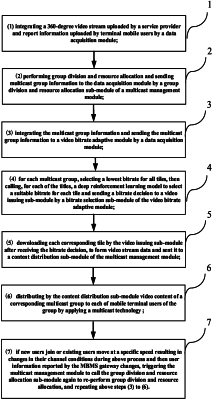| CPC H04N 21/816 (2013.01) [H04N 21/2407 (2013.01); H04N 21/41407 (2013.01); H04N 21/6405 (2013.01); H04N 21/64769 (2013.01)] | 4 Claims |

|
1. A system for real-time transmission of a panoramic video, comprising a BMSC network element, a MBMS gateway, a wireless base station and a connecting link, wherein the system further comprises following modules:
a data acquisition module deployed in the BMSC network element, wherein the data acquisition module is configured for: (1) integrating a 360-degree video stream uploaded by a service provider and report information uploaded by terminal mobile users, which specifically comprises: mapping the 360-degree video stream uploaded by the service provider into a video in a planar format by using projection, then encoding the video in the planar format by using an encoding scheme, and finally dividing an encoded video into corresponding format MDP files based on a corresponding network protocol for transmission; detecting values of channel quality indicators CQIs of the terminal mobile users in real time, and collecting Fields of view Fovs of a 360-degree video, numbers of re-buffering events, buffer lengths, average bitrate information for watched Fovs, space smoothness for the watched Fovs and time smoothness for the watched Fovs requested by the terminal mobile users during watching the video; (2) integrating multicast group information issued by a multicast management module, which specifically comprises: the number of multicast groups G, the number of people in each of the multicast groups Gg, a radio resource allocated for each of the multicast groups Xg, a proportion of people watching each tile, a size of each tile, each bitrate quality function, and an average buffer length for users in each of the multicast groups; (3) integrating video stream data and user information data, and sending integrated information to a video bitrate adaptive module, wherein the video stream data refers to size information, space coordinate information and all optional bitrate information of different segments tiles of the video, and the user information data is the multicast group information;
the video bitrate adaptive module deployed in the BMSC network element, wherein the video bitrate adaptive module comprises a bitrate selection sub-module and a video issuing sub-module; and wherein the video bitrate adaptive module is configured for: selecting qualities, i.e., bitrates, for different segments tiles of the video for all terminal mobile users in each of the multicast groups by the bitrate selection sub-module, and forming a video data stream from different segments tiles of the video with corresponding bitrates and sending the video data stream to a content distribution sub-module of the multicast management module by the video issuing sub-module;
the multicast management module deployed in the MBMS gateway, wherein the multicast management module comprises a group division and resource allocation sub-module and a content distribution sub-module; and wherein the multicast management module is configured for: (1) deciding whether to call the group division and resource allocation sub module for group division and resource allocation according to whether there is group division information in the MBMS gateway and whether received mobile user information changes; (2) performing group division and resource allocation by the group division and resource allocation sub-module, that is, dividing all mobile terminal users into different multicast groups, allocating radio resource blocks to different multicast groups, and sending the multicast group information to the data acquisition module; (3) after receiving the video data stream from the video bitrate adaptive module, distributing by the content distribution sub-module the video data stream to each of the mobile users of each of the groups by using a multicast technology.
|